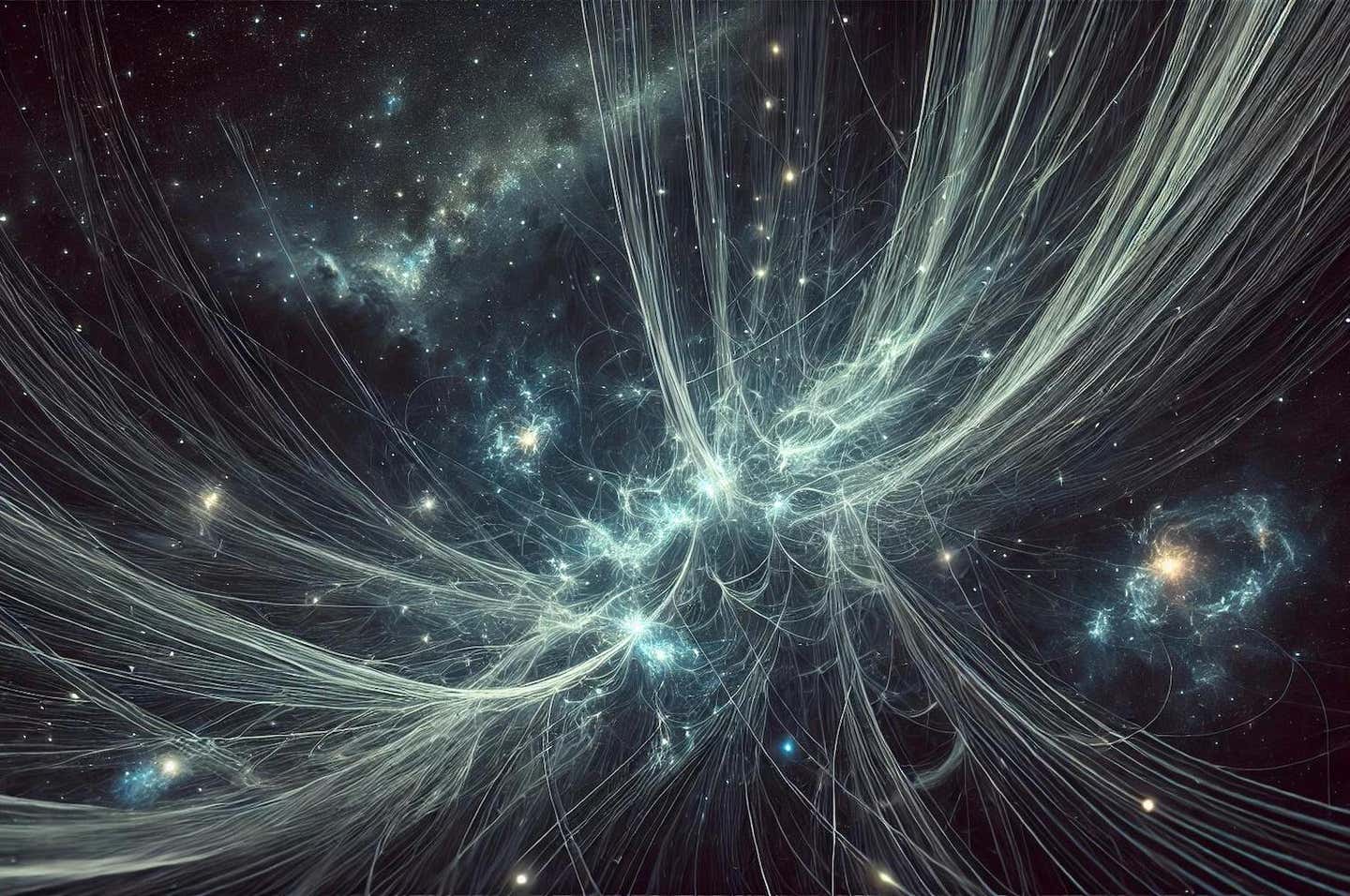Astrophysicists confirm first-ever detection of cosmic strings
Cosmic strings were first theorized in the mid-1970s as a possible outcome of symmetry-breaking processes in the early universe.

Cosmic strings are hypothetical topological defects, often described as “cracks” in the universe, that theoretically formed during the quantum chaos immediately following the Big Bang. (CREDIT: CC BY-SA 4.0)
The origin of the universe is a story of extremes, marked by an explosive event so profound it birthed the very fabric of space and time: the Big Bang. This moment, beyond the bounds of ordinary comprehension, laid the groundwork for everything we observe today.
In the first infinitesimal fraction of a second—less than a hundredth of a second after this cataclysmic event—the universe experienced a phase transition within its quantum field. This phenomenon, comparable to water boiling into vapor, but at temperatures incomprehensibly higher, may have created one of the most intriguing theoretical structures in cosmology: cosmic strings.
Cosmic strings were first theorized in the mid-1970s as a possible outcome of symmetry-breaking processes in the early universe. The concept emerged from the work of theoretical physicists Tom W. B. Kibble and others exploring the implications of grand unified theories (GUTs) for cosmology.
Kibble introduced the idea in 1976, proposing that as the universe cooled following the Big Bang, phase transitions similar to those in condensed matter systems could have produced defects in spacetime. These defects could manifest as one-dimensional structures with enormous energy densities, later named cosmic strings.
In the early 1980s, Alexander Vilenkin expanded on the theory by exploring how these strings could influence the large-scale structure of the universe, suggesting they might serve as seeds for galaxy formation.
Around the same time, researchers such as Edward Witten speculated about the potential connection between cosmic strings and superstring theory, providing a link between particle physics and cosmology. However, advances in observational astronomy and the rise of inflationary models in the 1980s and 1990s began to challenge the idea that cosmic strings played a significant role in structure formation.
Despite this, interest in cosmic strings persisted due to their potential as windows into high-energy physics and the early universe. Theoretical work by Thibault Damour and Alex Vilenkin in the 2000s suggested that cosmic strings could emit detectable gravitational waves, reigniting interest in their observational consequences.
Today, searches for cosmic strings continue through gravitational wave observatories like LIGO and Virgo, as well as through analyses of the Cosmic Microwave Background (CMB), the faint radiation left over from the Big Bang. However, despite extensive searches, the data has yet to yield definitive proof, leaving the existence of cosmic strings a tantalizing puzzle within modern cosmology.
Related Stories
The cosmic string hypothesis, somewhat sidelined after the initial excitement and subsequent disappointment, experienced a renaissance in the early 21st century through its intriguing connections with String Theory.
Advocates of this interdisciplinary approach postulated that cosmic strings, if detectable, could serve as observational signatures for the high-dimensional vibrations postulated by String Theory, thereby offering a unique peephole into the yet-unsubstantiated realms of this theoretical framework.
In this context, the recent announcement from the Indian Institute of Astrophysics has sent ripples through the scientific community.
Last month, the institute's researchers publicized the identification of several persuasive cosmic string candidates, with one specific field of space, designated as CSc-1, drawing particular interest.
Their findings, while still awaiting peer review, have been preliminarily published in the Bulletin de la Société Royale des Sciences de Liège and are accessible on the arXiv preprint server.
The focal point of this groundbreaking study is an enigmatic duo of bright galactic entities cataloged as SDSSJ110429.61+233150.3. These celestial bodies, initially perceived as a pair of separate galaxies, are postulated by the research team to be a single galaxy, its image cleaved into two distinct components due to a phenomenon known as gravitational lensing.
This process, where the gravitational fields exerted by massive celestial bodies distort and bifurcate the light from objects behind them, is typically associated with the immense gravitational pull of galaxy clusters. However, in this instance, the researchers propose a different lensing agent: a cosmic string.
In the study, the team found, "The significant correlation between the spectra of the two components indicates the possible GL (gravitational lensing) nature of the pair. Our simulations of observational data in the CSc-1 field shows that a large number of pairs can be explained by the complex geometry of the CS (cosmic string)."
They further discuss their simulations of the SDSSJ110429 galaxy pair, revealing, "The observed angle between the components of the pair can be explained if the CS is strongly inclined and, possibly, bent in the image plane."
This hypothesis, while compelling, carries its share of uncertainties, largely due to the unprecedented nature of the findings. Cosmic strings, if they exist, represent remnants from the universe's infancy, and no concrete evidence of such primordial defects has been previously documented.
The researchers, therefore, proceed with scientific prudence. They recognize the possibility that the absence of detectable mass between the “twinned” galaxies could suggest that they are indeed separate entities.
Nonetheless, the identical nature of the light spectra from the two components bolsters the argument for their being duplicates, resulting from the gravitational influence of a cosmic string.
In pursuit of further clarity and potentially irrefutable evidence, the scientists recommend an intensive examination of the CSc-1 field, employing the advanced capabilities of a 4-meter class telescope. One such observatory, the Devasthal Optical Telescope, situated in Nainital, India, could play a crucial role in this investigative endeavor.
While the study stops short of providing the unequivocal evidence that astrophysicists have been zealously seeking for over fifty years, it marks a potentially significant milestone in our cosmic quest.
The journey to understanding cosmic strings is akin to threading a needle in the dark expanse of space; the task is meticulous, the target elusive, and the implications profound.
Whether these findings will solidify into the long-sought proof of cosmic strings' existence or dissolve into the cosmic background remains to be seen. However, the pursuit of such knowledge underscores humanity's relentless quest to decipher the universe's deepest mysteries and the fundamental forces that shape the very fabric of our existence.
Note: Materials provided above by The Brighter Side of News. Content may be edited for style and length.
Like these kind of feel good stories? Get The Brighter Side of News' newsletter.
Joseph Shavit
Head Science News Writer | Communicating Innovation & Discovery
Based in Los Angeles, Joseph Shavit is an accomplished science journalist, head science news writer and co-founder at The Brighter Side of News, where he translates cutting-edge discoveries into compelling stories for a broad audience. With a strong background spanning science, business, product management, media leadership, and entrepreneurship, Joseph brings a unique perspective to science communication. His expertise allows him to uncover the intersection of technological advancements and market potential, shedding light on how groundbreaking research evolves into transformative products and industries.



